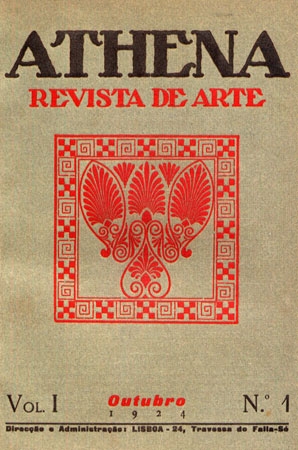
Athena was a monthly art magazine, launched in Lisbon in October 1924 and reached five issues, with literary direction by Fernando Pessoa and artistic direction by Ruy Vaz. Athena's penultimate issue comes out in January 1925, and the last one, despite being dated February, doesn't actually come out until June, which may have to do with his mother's death on March 17th.
This is the second magazine that Pessoa is director of, ten years after the glorious catastrophe with Orpheu. And, if in this one he appeared under the name Álvaro de Campos, in addition to his own, in Athena he will finally reveal the names of Ricardo Reis and Alberto Caeiro. That is why it can be said – in addition to the deliberate proximity of the titles – that there is a substantial difference between the two magazines, the first about combat and scandal, the second about explanation and construction – above all, of heteronymia itself as a system of poets. This aim is accomplished by publishing relatively extensive sets of their poems. Thus, Ricardo Reis is revealed at nº1 with 20 compositions: “Odes. Book First”. Alberto Caeiro publishes two “choices of poems”: 22 poems from O Guardador de Rebanhos in nº4, and 16 from Poemas Inconjuntos in nº5. The method of presentation of heteronyms is the same as that of the authors: it does not editorially link any of the three heteronyms to Pessoa (as in Orpheu 1, where the subtitle 'two compositions by Álvaro de Campos published by Fernando Pessoa' still appears), and in the case of Alberto Caeiro, he even inserts likelihood operators, putting under the author's name the dates of birth and death (1889-1915), and, under one of the 'poem choices', the dates of his writing, the first (1911- 1912) and the second (1913-15). The case of Álvaro de Campos is unique, as his publications are all in essayistic prose, and the first (“O que é a Metafísica” - 'What is Metaphysics?', nº2) presents itself as a discussion of certain points in the editorial that Pessoa had placed in the opening of nº1, followed in nº3 and 4 a capital article “Para uma Estética Não-Aristotélica” (“Towards a Non-Aristotelian Aesthetics”). The uniqueness of Álvaro de Campos is accentuated more by the fact that Mário Saa decided to enter the game, publishing an article in which he debated Álvaro de Campos, and in that intervention he mentioned twice that Álvaro de Campos' talent was “only comparable to that of Fernando Pessoa”. In other words, in the cultural orbit of the modernists, Álvaro de Campos is another name for Pessoa.
In addition to the introductory article in nº1, which exalts the sense of cultural improvement that is linked to the name chosen for the magazine (“You don't learn to be an artist: you learn, however, to know how to be one […] Each one has the Apollo that seeks, and will have Athena to seek"), Pessoa publishes a series of 16 poems under his own name in nº3, and its translations by Poe, O. Henry and Walter Pater. He presents the Last Poems of Sá-Carneiro, who had been his dearest friend, as well as Almada Negreiros, António Botto, Raul Leal, Augusto Ferreira Gomes, Luiz de Montalvor, Mário Saa and publishes poems by Henrique Rosa, stepfather's brother and much of his own next. As one can see, Athena is a magazine tailored to the perfect image of Pessoa and his intimate affective circle.
With another important component: the part dedicated to the visual arts and architecture, directed by Ruy Vaz, which includes articles and several pages of reproductions, and in which Almada Negreiros and Milly Possoz stand out, in addition to other articles and reproductions in that the journal's quasi-academic climate sometimes looms large.
It is known, however, that Athena began to be thought of in the late 10s as a periodical designed to project only one aspect of the heteronymic universe, Neopaganism. Thus, it is even foreseen with the subtitle Cadernos de Cultura Superior, with a summary that includes only António Mora, Alberto Caeiro, Fernando Pessoa and Ricardo Reis, and, likewise, with the subtitle of “Cadernos de Reconstrução Pagã” and directed by António Mora, enters the programming of the publishing house Cosmópolis, around 1919. It should also be noted that, when the magazine was completed in 1924, there was an editing plan, connected with it, of a series of fifty small anthologies by Portuguese authors, from Bocage to Ângelo de Lima, and classics like Horacio or Omar Khayyam, and moderns like Edgar Poe or Mallarmé.
Fernando Cabral Martins
